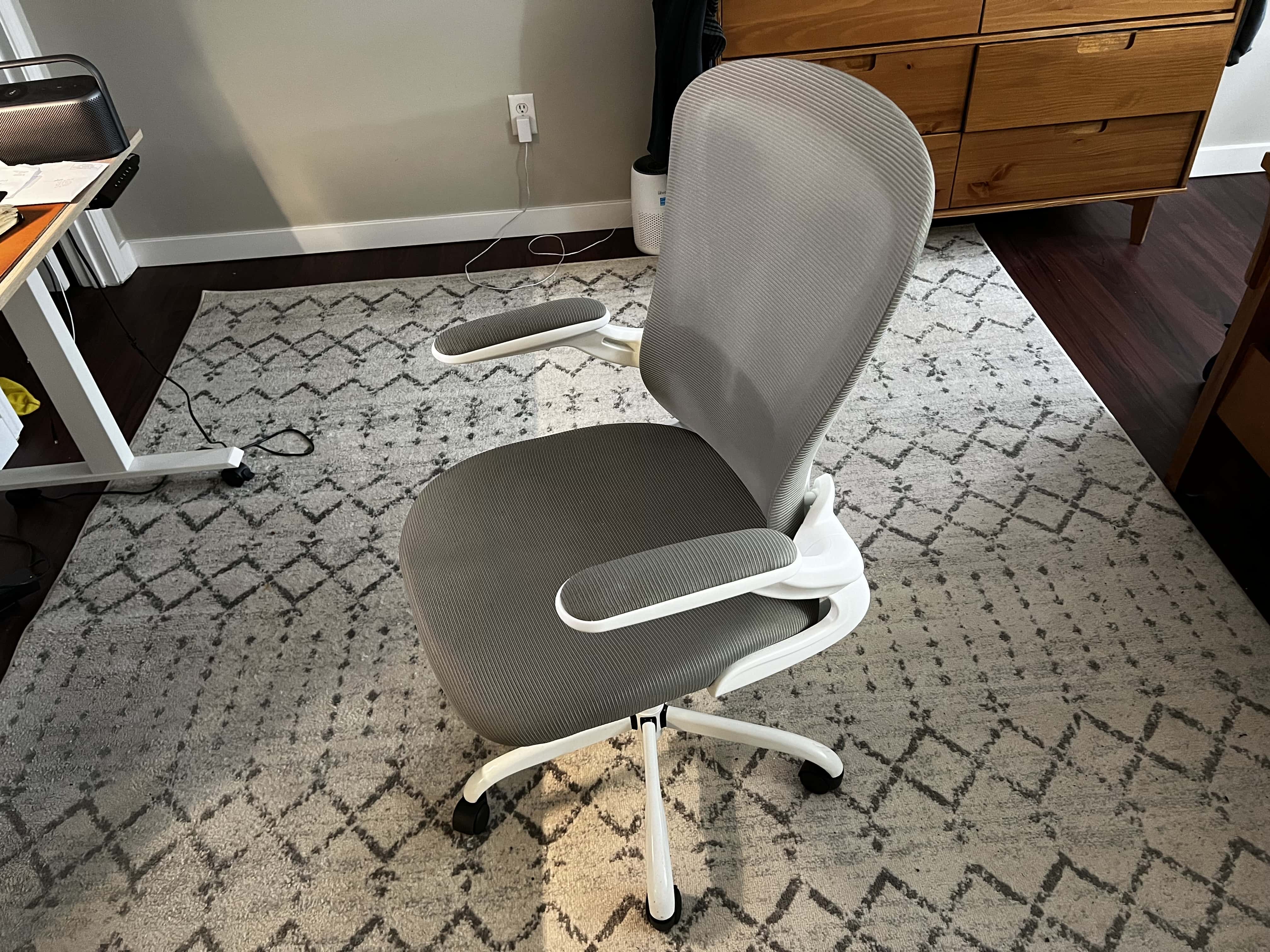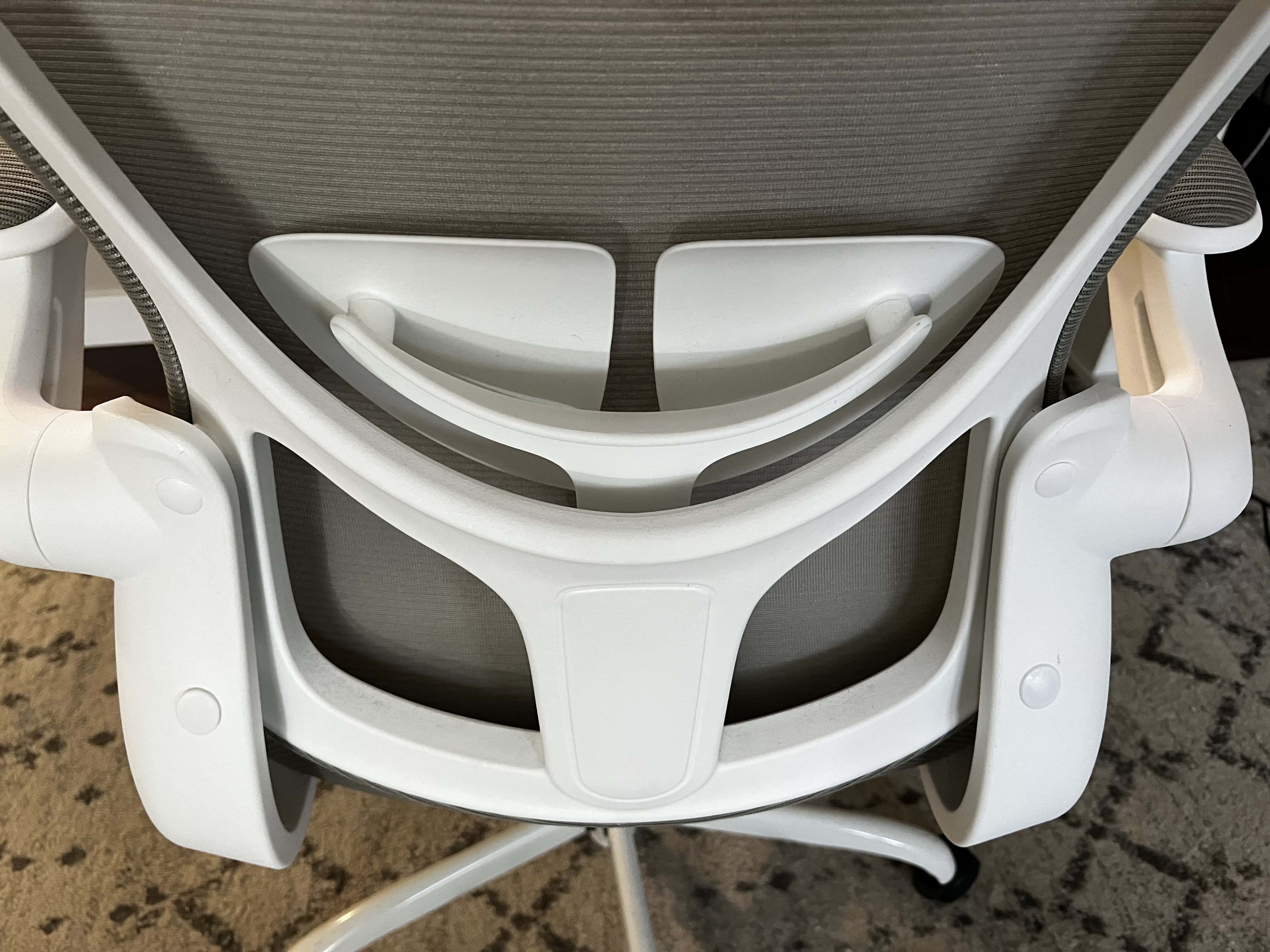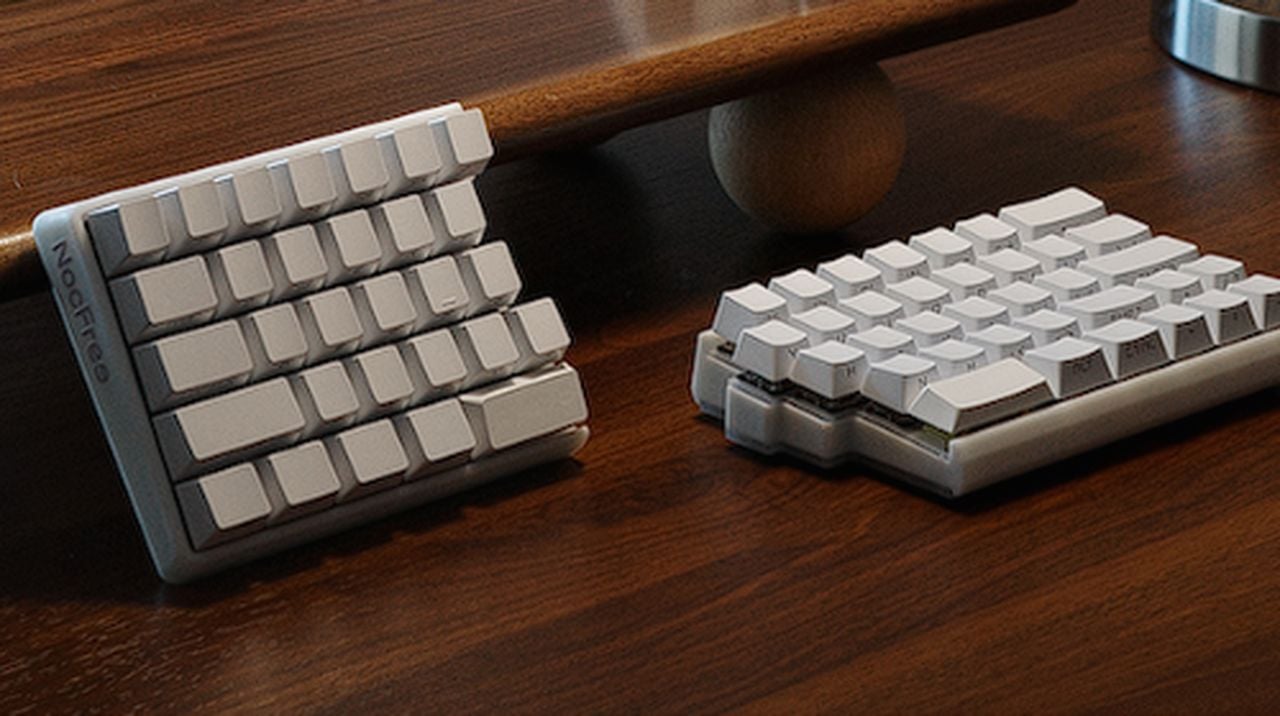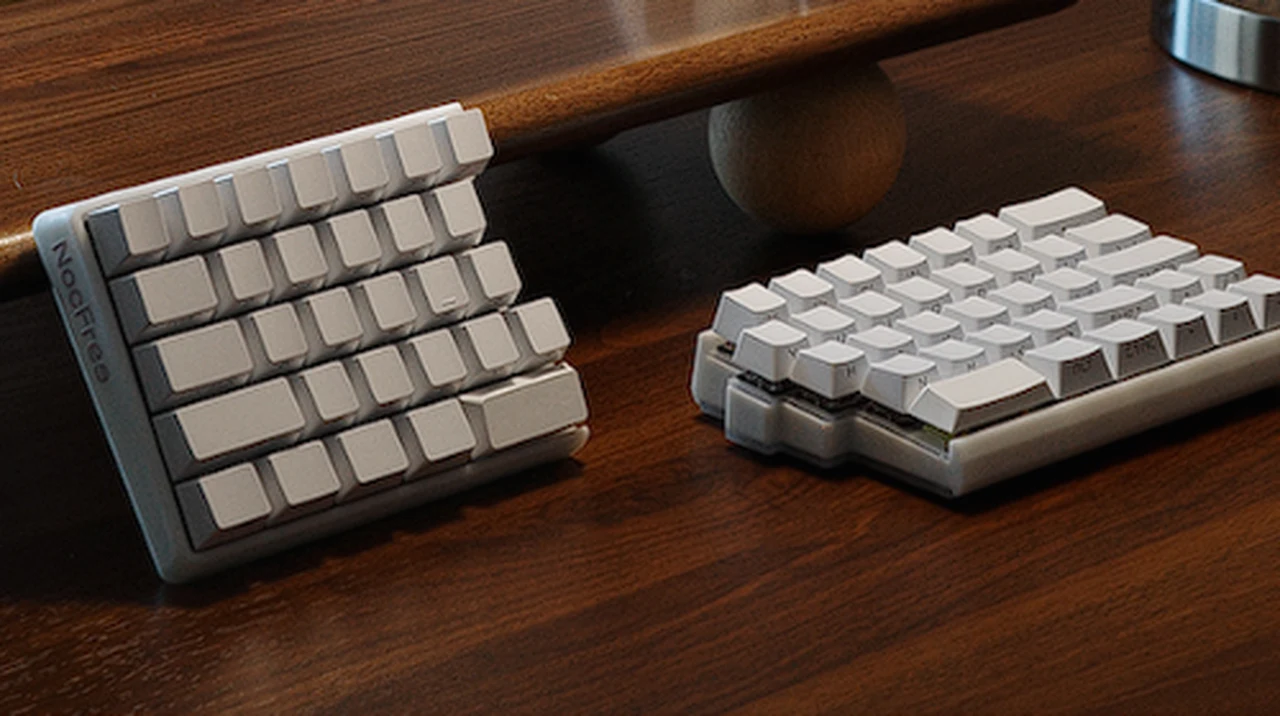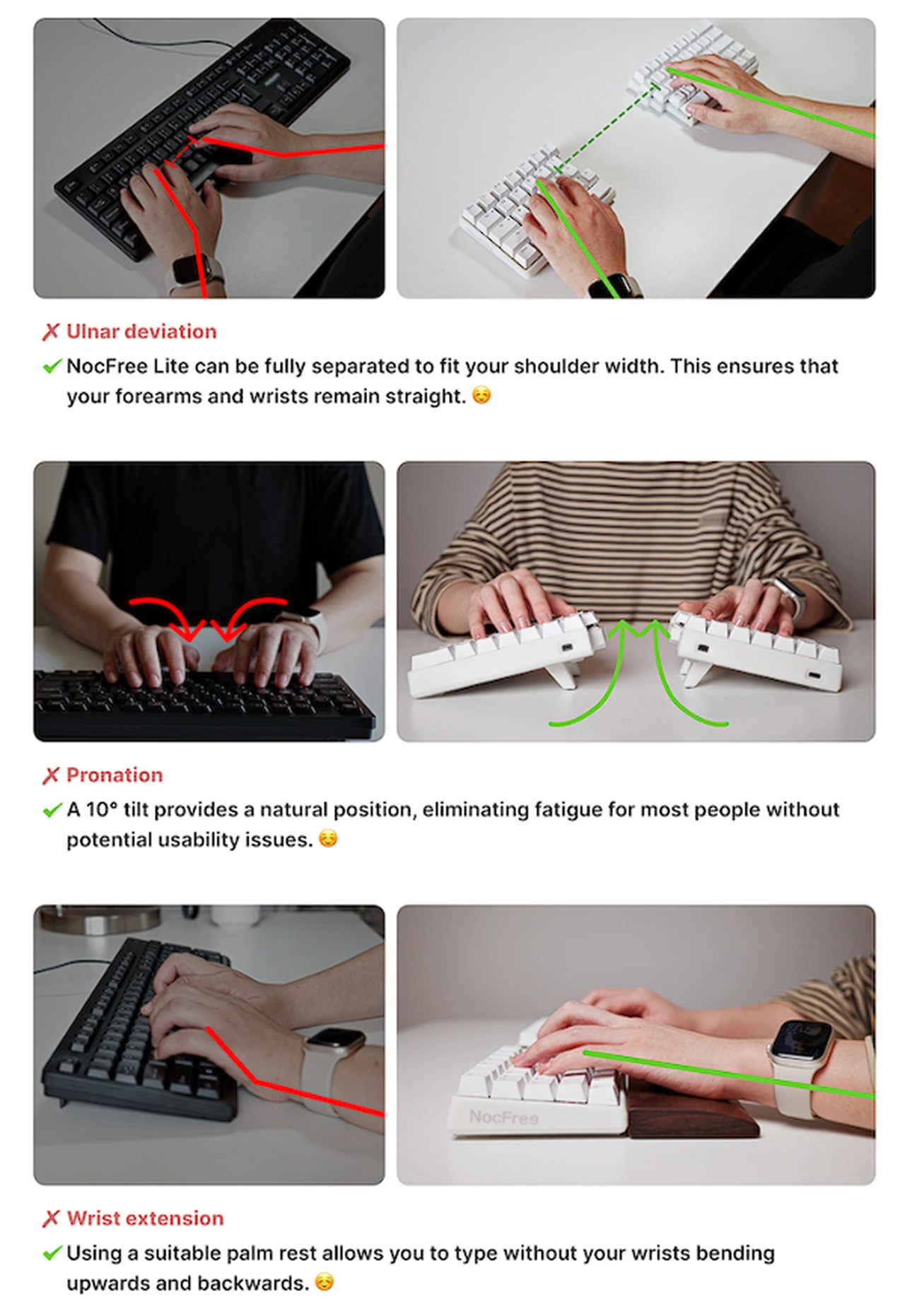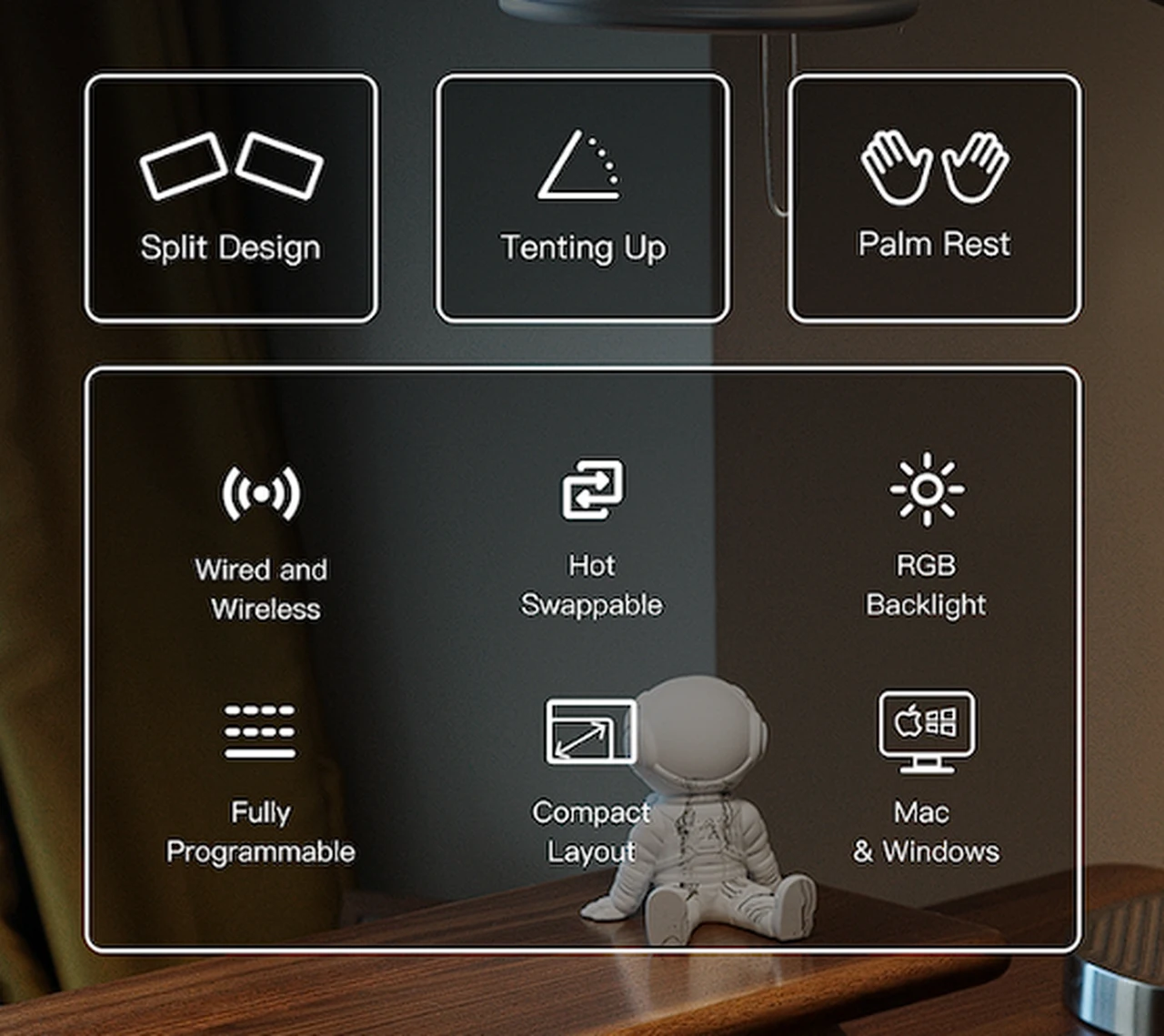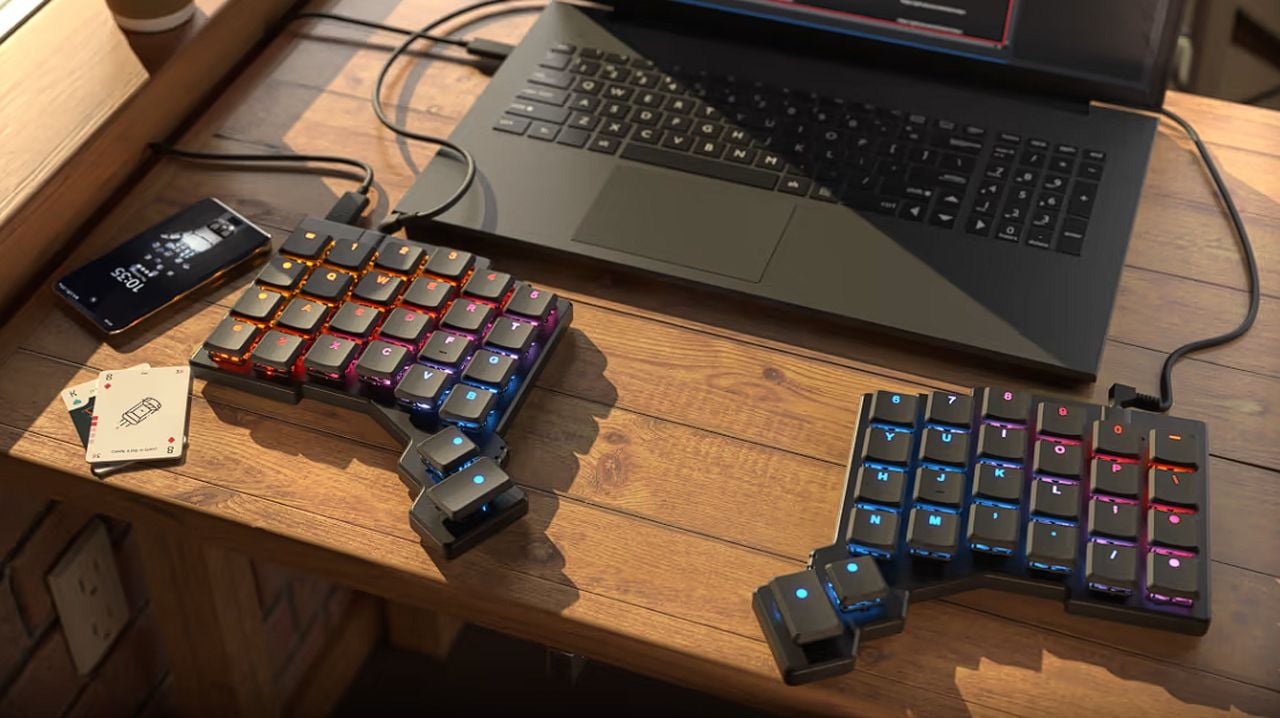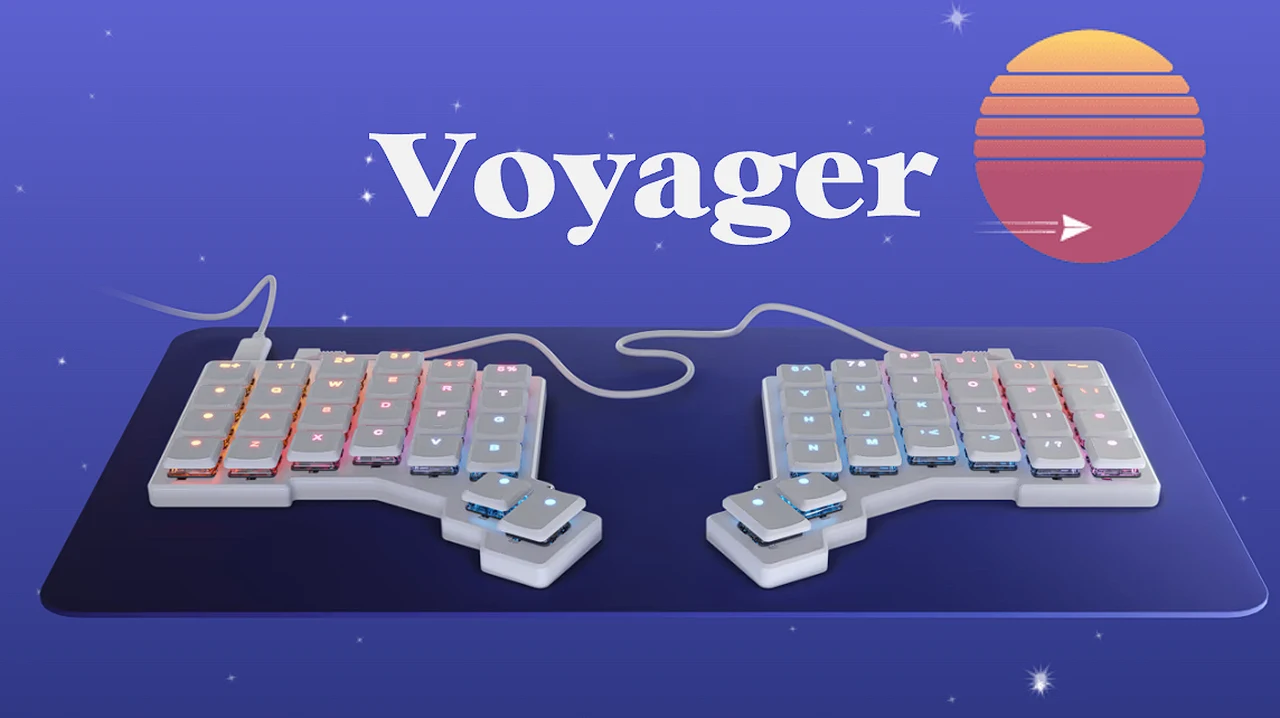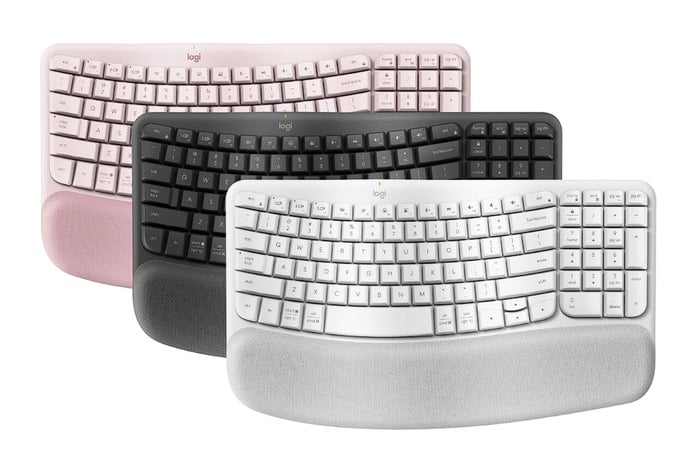[ad_1]
Staggered vs columnar
This decision seems to be one of the more hotly-contested among ergo enthusiasts. A standard keyboard has staggered keys, with each row slightly offset to the rows above and below it — so the A key is about halfway between the Q and W above it. This is a holdover from vintage mechanical typewriters, in which each press activated a hammer that smashed ink onto paper in the shape of a letter. To fit the hammers as close together as possible, while still allowing for finger pads, the keys were staggered.
Columnar or ortholinear keyboards stack the keys in orderly columns, often with rows that are not linear. Proponents claim this makes the keys easier to reach. Whether that’s true will be up to your fingers to decide, but I can say for certain that if you learned to type on a staggered keyboard, switching to a columnar layout is tough. It will take days, possibly weeks before you instinctively hit the C key. The N, M and B keys don’t fare much better.
Programmable keys
With a few exceptions, most ergonomic keyboards will work with PCs or Macs as a standard typing input, but the use of function and hot keys may require some remapping. It can be as easy as an onboard switch to toggle between Mac and PC layouts, or as involved as downloading software to change up the keys. Some boards even include (or let you buy) extra keycaps to change, say, the Mac’s Command and Option keys to PC’s Start and Alt buttons.
For some boards, remapping or programming keys is a crucial feature. Gaming peripherals have extra keys that you can set to execute a series of keystrokes with the push of a single button. Keyboards that work with layers, in which a single button can perform several functions, typically allow you to change what those are. Some ergonomic keyboards have non-standard layouts, like thumb clusters with multiple keys near the space bar that you operate with your thumb. You’ll also be able to program those.
Other considerations
Ergonomic keyboards come in mechanical, membrane, and scissor switch versions. Which works best for you is, again, up to your preference. I won’t get too deep into the particulars here, but the short of it is that membrane and scissor switches are less customizable than mechanical and typically cheaper. Typing on them tends to be quieter and softer. Mechanical switches are more customizable, offer a more responsive typing experience and are usually pricier.
You’ll also have the option of wired or wireless ergonomic boards. All other things being equal, wired models are less expensive. Competitive gamers who rely on split-second responses may prefer the zero-lag of wired keyboards. Wired models also never run out of battery life and have fewer connectivity issues. But wireless keyboards keep your desk less cluttered.
Some ergonomic keyboards come with permanent or removable wrist or palm rests, which can be cushioned or hard. This is another area where opinions diverge: proponents claim they help you maintain a neutral hand position, while detractors say they put pressure on the tendons in your wrist. Ideally, your palms should be resting, not your wrists, and you might find you like having that support or you may find the pressure uncomfortable.
How we tested
All our guides begin with extensive research to figure out what’s out there and what’s worth testing. We consider brands with good reputations that we’ve heard good things about from colleagues and other trusted publications. For this guide, I looked for keyboards with ergonomic features like tenting, split keys, palm support and so on. I also zeroed in on boards that didn’t require a deep amount of familiarity with the vast and exhaustive world of custom keyboards.
Once I settled on ten boards, I acquired them and used each one for anywhere from a few days to a few weeks. I tried out the remapping and macros software and considered the comfort, design, price and durability of each model before arriving at picks I think will work best for the most people out there.
Ergonomic features: Alice split, center tenting, optional negative tilt, wrist rest | Host connection: Bluetooth or USB receiver | Switch type: Scissor | Hotkey compatibility: Mac and Windows | Ten key: Yes | RGB lighting: No | Programing interface: Logi Options+ (app)
The Ergo K860 from Logitech closely resembles a standard keyboard, so there’s not much of a learning curve. But subtle changes like the Alice layout, tented middle and optional negative tilt make typing noticeably more ergonomic. Logitech makes some of our favorite PC accessories, and the reasons why are all evident with this keyboard: it connects quickly and reliably via Bluetooth, the build is solid and feels high-quality and it’s reasonably priced at $130 (and is often on sale for around $100).
It’s compatible with more recent iterations of Windows, MacOS, iPadOS, ChromeOS and Linux, though you’ll need software to support non-basic key functions for the latter two operating systems. There are three switching buttons that swap between previously connected devices, and the board speedily swapped between a MacBook and a PC laptop in my tests. Built-in function keys like volume and brightness worked well and the Option/Start and Command/Alt combo keys worked correctly depending on which computer was connected to.
The rotated Alice-split design and raised center made a difference in the way I held my arms as I typed, allowing me to keep my elbows comfortably away from my ribs and my palms rotated inward instead of forcing them flat. The palm rest is springy but firm (albeit not removable) and the arrow keys and a numeric keypad on the right side put all possible keys within reach. Unfortunately, that adds length to that side of the board, which forces your mouse farther out. The scissor switch keys can feel mushy if you’re coming from a mechanical board, but they’re responsive enough. Logitech offers software for programming the keys, but this model will likely appeal most to those looking for a plug and play option.
For a mechanical Alice keyboard with both wireless and wired capabilities, I recommend the Periboard 835. The Mac and Windows-compatible board has a solid build, low profile switches, RGB lighting, comfortable tenting and a few extra programmable keys.
- Rotated keys and palm wrest make typing comfortable
- Wirelessly connects quickly to three devides
- Hotkeys work with MacOS and Windows
- Takes up a large footprint
- Wrist wrest is not removable
Ergonomic features: Fully split | Host connection: USB-C port | Switch type: Mechanical (tactile or linear) | Hotkey compatibility: Mac and Windows | Ten key: No | RGB lighting: Yes | Programing interface: QMK/VIA (browser)
If you (expertly) sawed a mechanical keyboard in two, it would look like the Keychron Q11. You can even push the two halves back together to make it look like a standard, 75 percent mechanical board (though once you discover the expediency of a snack bowl between the halves, I don’t know why you’d do that).
Keychron is widely respected in the mechanical keyboard world because they make quality keyboards that aren’t astronomically expensive. Like all Keychron devices, you can buy this one assembled or barebones, to which you can add your own keycaps and switches. I tested a fully assembled model with Gateron G Pro Red linear mechanical switches, which provide smoother action and a quieter clack than tactile or clicky switches. The keycaps are made from PBT, a higher-quality polymer than the ABS plastic keys found in less expensive keyboards. The machined aluminum body feels substantial and there’s no wobble. All of that combined creates a luxe and durable feel and a satisfying, buttery clack as you type.
The assembled version comes with keycaps (and a keycap puller) to set up the board for either Mac or Windows. A switch at the top of the board toggles between the two operating systems, ensuring the function keys act appropriately. Extra keys include the two customizable knobs at the top corners and five macro keys to the left of the board. Those and the rest of the board can be programmed with open source keyboard firmware QMK and VIA, which most Keychron boards are compatible with out of the box.
I have very basic keyboard needs so I used VIA to give the right knob zoom capabilities, make the M1 key open a clipboard manager and have the M2 key execute a screenshot. Programming with VIA requires the use of keycodes and you’ll need to define macros within the app to get the knob to do more advanced things beyond the pre-selected options, but the implementation of your new instructions is instantaneous (and quite satisfying).
The only drawbacks are the lack of tenting and the rather short USB-C bridge cable connecting the two sides. I found I wanted a little more separation than nine inches, so I swapped it for a longer cord. But there’s no easy fix for the lack of center lift.
- High quality build
- Smooth and buttery mechanical keys
- Fully split keys keep your hands at a comfortable distance apart
- Easily toggle between Mac and Windows systems
- No center tenting
- Short bridge cable included
Ergonomic features: Alice split, center tenting, wrist rest | Host connection: USB-A cable | Switch type: Membrane | Hotkey compatibility: Windows | Ten key: Yes | RGB lighting: No | Programing interface: N/A
Perixx makes a number of ergonomic keyboards and the Periboard 512 offers basic features at a low price. The standard keys will work with a Mac, but the included media keys and function keys are programmed for Windows machines. It worked well on the PC I tested it with, jumping to the search bar, opening the built-in Mail app and muting the sound when I hit the respective keys. The membrane keys are sturdy without wobble and the Alice split and tenting put your hands in a comfortable position. The rigid wrist rest angles down, which makes it easier to rest your palms and not your wrists.
At just $70, the 512 isn’t the most premium board and you can feel that in the lightweight design and cheaper-feeling keycaps. But if you’re just looking for a basic Windows interface with ergonomic features that’ll take some of the strain off your work posture, this is an inexpensive way to go.
- Inexpensive
- Alice split makes typing more comfortable
- Helpful hot keys
- Build does not feel premium
- Hotkeys only compatible with Windows
Ergonomic features: Fully split, center tenting, thumb cluster | Host connection: USB-C port | Switch type: Mechanical (tactile, clicky, linear) | Hotkey compatibility: Mac and Windows | Ten key: No | RGB lighting: Yes | Programing interface: Oryx (browser)
A rep I spoke with at ZSA warned me about the Voyager, saying the board has an effect “like a brain injury: A moment ago you knew how to type, and now you don’t.” That’s exactly how I felt after plugging in the impossibly compact accessory. For one, the columnar layout puts keys (particularly those on the bottom row) in spots you don’t intuitively reach for. Then there’s a thumb cluster where you’ll find not just the space bar, but other important keys like return. Finally, the board uses layers, giving each key up to three functions.
I actually had to interrupt testing at one point and plug in another keyboard because I just felt too slow and disconnected like I was typing with oven mitts on. However, now that I have the hang of how the Voyager works, it feels magical. Rarely do my hands need to leave the home position, yet every key I need on a regular basis is easily accessible.
Since you don’t need to reorient your fingers when you use arrow keys, hit the mute button or type with the number pad, you’re always in the same position, which can save you some serious accumulated time. Your thumbs, which are fairly dexterous, are capable of doing more than just mashing the spacebar; here, they operate the return key, tab button and can even initialize layers. The fully split and extra compact design let you position the two boards anywhere they feel comfortable and the optional magnetic legs give it a subtle but effective center tenting.
Where some keyboards offer remapping capabilities as a nice-to-have feature, the majority of people will likely want to use either the browser-based Oryx configurator or Zsa’s Keymapp app to switch up what these keys do. It took me multiple tries to get them set in a way that worked for me, so I got pretty familiar with Oryx. It doesn’t require you to lookup keycodes, instead giving you a vast library of searchable commands. But changes aren’t implemented automatically — you have to flash the keyboard’s firmware by pushing a button at the top edge of the device to make the changes.
Certain system-specific functions, like the Mission Control key on a Mac, need to be programmed using key sequences (in this case, control + down arrow). And occasionally the board will mistake a single tap for a tap and hold (which often enables a second function). I also flashed the board once and lost all use of the right side, but reflashing fixed it.
The Voyager is not for someone looking for a quick adjustment to improve their ergonomics. It’ll take weeks of practice and reprogramming (both the board and your brain) before typing feels fluid again. I recommend keeping a screenshot of your latest Oryx-configured layout on your desktop for reference until you remember which keys do what. That said, once things start clicking, the Voyager really does maximize your output while minimizing your movements.
If you want something fully split with thumb clusters and a columnar layout but that’s a little less minimal — and wireless to boot — the Kinesis Advantage 360 is a good one to check out. It looks like it comes from an ‘80s-era IBM office but is somehow also from the future. The tenting goes from low to intense and the keys curve concavely to meet your fingers where they naturally land. The 360 is per-key programmable, works with layers and has four macros keys.
- Fully split board
- Center tenting for a natural hand position
- Thumb cluster lets your thumb do more work
- Compact size and clever key mapping keep your hands in the home position
- Difficult to relearn ortholinear layout
- Takes time to program and learn the right key functions
Ergonomic features: Fully split, center tenting, removable wrist rest | Host connection: USB-A cable | Switch type: Mechanical (tactile, clicky, linear) | Hotkey compatibility: Mac and Windows | Ten key: No | RGB lighting: Yes | Programing interface: SmartSet (app)
PC gamers who rely on the WASD keys may appreciate not having to contend with the right side of a keyboard at all, and instead use that space for their mouse. The Freestyle Edge from Kinesis is a fully split model with Cherry MX mechanical switches. The tactile Brown ones in my tester unit had a satisfying click and a not overly loud clacky noise. The wrist rests are removable and clever folding legs give you three height options for tenting and can be removed completely.
It has per-key RGB lights and nine macros buttons that can be programmed with the configuration app or without it using keyboard commands. All of this may appeal to gamers looking for a programmable keyboard with a few ergonomic tricks. Just keep in mind that all of those features add up to a somewhat bulky peripheral.
- Fully split means you can just use the left half
- High degree of optional tenting
- Additional programmable shortcut keys
- Somewhat bulky
- Built-in cables are not customizable
[ad_2]
Source Article Link


